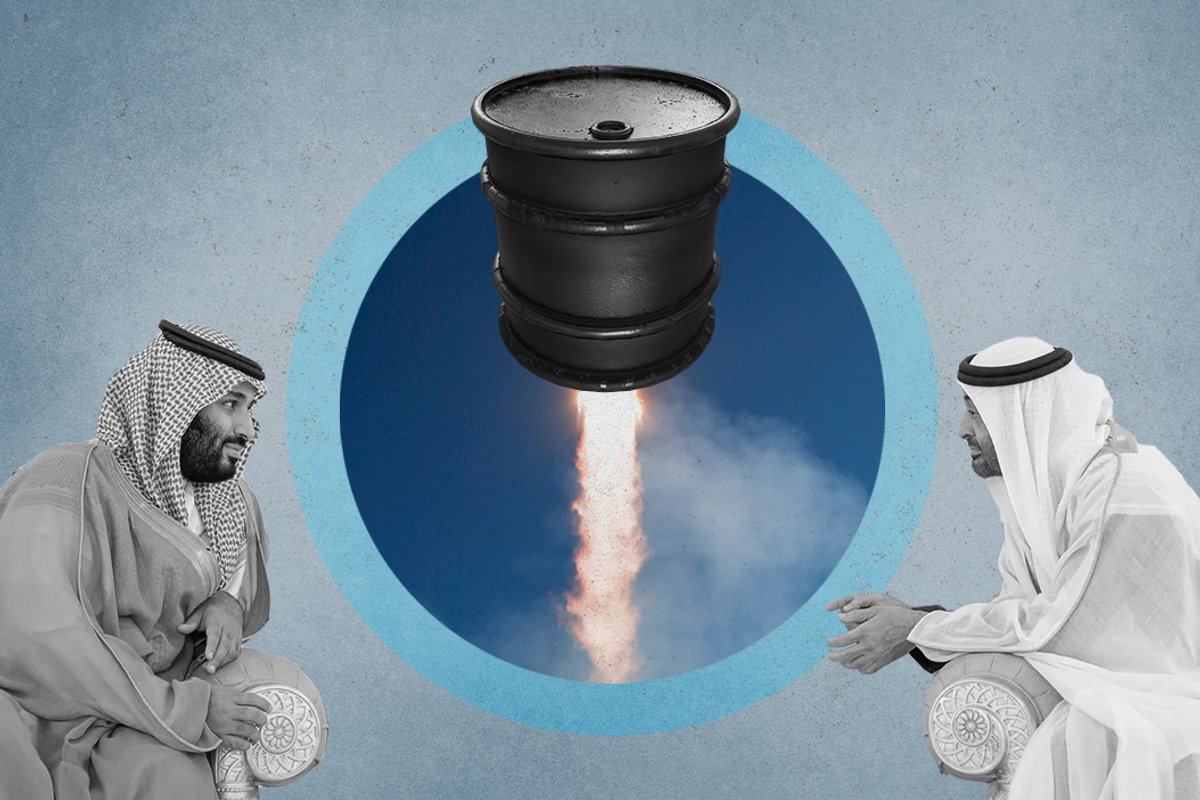Oil prices have risen roughly 50 percent since the start of the year to about $75 per barrel, contributing to sharply higher prices for essential fuels such as gasoline. That's a dark cloud at a time when the global economic recovery is still fragile. One reason for the price spike is higher demand in North America and Europe, where successful COVID vaccination campaigns are allowing countries to lift their lockdowns and get their economies roaring again. But there's more to the story. We asked Eurasia Group analysts Henning Gloystein and Ayham Kamel to explain.
What's behind the oil price spike?
It's an interesting situation. While demand for oil is rising, especially in the US and Europe, globally it's still below pre-pandemic levels. That's largely because restrictions on international aviation remain in place, meaning there's very little demand for jet fuel, one of the main products made from crude oil.
In fact, the recent oil price rise has more to do with production restraint from major oil producers, especially the members of the OPEC cartel.
How does OPEC fit into the story?
This group, under the de facto leadership of Saudi Arabia, the world's biggest oil exporter, has traditionally tried to strike a balance: keeping oil prices high enough for producers to enjoy strong export revenues but not so high that they cause economic damage around the world that chokes off consumption. Since last May, OPEC has acted in concert with non-OPEC producers like Russia and a few Central Asian states to maintain that balance, even as markets have seesawed between bouts of recovery and renewed lockdowns. But with demand now showing signs of sustained improvement, everyone is seeing dollar signs and coordination among them has broken down.
Why has intra-OPEC coordination fallen apart?
When oil prices rise, consensus within OPEC tends to grow weaker as everyone tries to cash in. Specifically, they are — as usual — arguing over the national production quotas that each OPEC member agrees to as part of the cartel. This time around, the UAE, OPEC's third biggest producer behind Saudi Arabia and Iraq, wants its current quota of 3.2 million barrels per day (bpd) to be raised by around 500,000 bpd, to reflect its recent investments in new oil production capacity. But the Saudis have rejected this demand. They are worried that if one member is allowed to increase its quota, all the others would want to do the same. That could result in too much oil production, leading to lower prices for everyone.
Sort of a prisoners' dilemma, it seems. So what is the near-term outlook for prices then?
If there's a compromise in the coming weeks within OPEC, in which its members agree to produce more oil, that would bring down prices, but probably not before they breach the $80-per-barrel mark. On the other hand if there's no movement from OPEC and no increase in supply, that may lead to a bigger price surge — we wouldn't rule out $100 per barrel. That, however, would probably only be a temporary price spike, because at that level there is a serious risk that higher prices would cause demand to fall, particularly in emerging markets which are much more sensitive to higher prices. Finally, there's a slight chance that OPEC's system of agreed upon quotas falls apart entirely: if that happens, they'll all start producing as much as they can, resulting in a wave of unneeded oil hitting the market, crashing prices fast.
OK, for those of us planning a road trip, how does all this translate into gasoline prices?
Oil refiners are the critical piece here. They are the ones who buy crude oil and process it into the fuels we all use: including gasoline, diesel, and jet fuel. So when the cost of crude oil rises, the refiners' margins shrink. The easiest and most common solution for them is to simply pass on those higher costs to consumers via increased gas prices at the pump. If they overdo it, however, that can kill off consumption. This is especially the case in emerging markets, where most households simply cannot afford sharp increases in fuel prices. When prices surge, people simply stop driving their motorbikes or using taxis, though the governments of some countries try to shield consumers from the increases by giving fuel subsidies to households or by forcing refining companies to eat the costs themselves. Even in wealthier countries such as the US, if fuel gets too expensive, people simply drive less, especially during the summer driving season.
How does climate policy affect the longer-term outlook for oil demand and prices?
The green energy transition is accelerating, and analysts now think the point at which global oil consumption starts to fall will come sooner than expected. Previously, most didn't expect that to happen until 2030 or even 2040. Now some think we may already have crossed that point in 2019, just before the pandemic hit. What is certain is that electric vehicle growth is already exponential in most major economies, and this is a major blow to the fossil fuels industry. By 2030, and perhaps earlier, the majority of cars sold in Northeast Asia, Western Europe, and in North America will be electric. By that point, the oil industry will have to rely increasingly on sales to emerging markets, where the energy transition is further behind. But if these countries also manage a rapid electrification of transport, then oil demand will enter a sustained decline. And looking beyond electric vehicles, at some point, fossil fuels will also be eliminated from bigger vessels such as cargo ships or even airplanes, possibly by hydrogen fuel cells or liquid ammonia.






